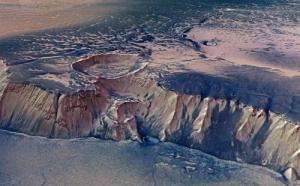A Tale of Planetary Woe (w/ Video)

Once upon a time — roughly four billion years ago — Mars was warm and wet, much like Earth. Liquid water flowed on the Martian surface in long rivers that emptied into shallow seas. A thick atmosphere blanketed the planet and kept it warm. Living microbes might have even arisen, some scientists believe, starting Mars down the path toward becoming a second life-filled planet next door to our own.
But that's not how things turned out.
Mars today is bitter cold and bone dry. The rivers and seas are long gone. Its atmosphere is thin and wispy, and if Martian microbes still exist, they're probably eking out a meager existence somewhere beneath the dusty Martian soil.
What happened? Why did Mars dry up and freeze over? These haunting questions have long puzzled scientists. A few years from now we might finally know the answer, thanks to a new orbiter NASA will send to Mars called MAVEN (short for Mars Atmosphere and Volatile Evolution).
"The goal of MAVEN is to figure out what processes were responsible for those changes in the climate," says Bruce Jakosky, Principal Investigator for MAVEN at the University of Colorado at Boulder.
One way or another, scientists believe, Mars must have lost its most precious asset: its thick atmosphere of carbon dioxide. CO2 in Mars's atmosphere is a greenhouse gas, just as it is in our own atmosphere. A thick blanket of CO2 and other greenhouse gases would have provided the warmer temperatures and greater atmospheric pressure required to keep liquid water from freezing solid or boiling away.
Over the last four billion years, Mars somehow lost most of that blanket. Scientists have proposed various theories for how that loss happened. Perhaps an asteroid impact blew most of the atmosphere into space in one catastrophic event. Or maybe erosion by the solar wind — a stream of charged particles emanating from the sun — could have slowly stripped the atmosphere away over eons. The planet's surface might also have absorbed the CO2 and locked it up in minerals such as carbonate.
Ultimately, nobody knows for sure where all the missing CO2 went.
MAVEN will be the first mission to Mars specifically designed to help scientists understand the ongoing escape of CO2 and other gases into space. The probe will orbit Mars for at least one Earth-year. At the elliptical orbit's low point, MAVEN will be 125 km above the surface; its high point will take it more than 6000 km out into space. This wide range of altitudes will enable MAVEN to sample Mars's atmosphere more thoroughly than ever before.
As it orbits, MAVEN's instruments will track ions and molecules in this broad cross-section of the Martian atmosphere, thoroughly documenting the flow of CO2 and other molecules into space for the first time.
Once Jakosky and his colleagues know how quickly Mars is losing CO2 right now, they can extrapolate backward in time to estimate the total amount lost to space during the last four billion years. "MAVEN will determine if [loss to space] was the most important player," Jakosky says.
But just as important as "how much?" is the question of "how?"
Conventional wisdom holds that Mars's atmosphere is vulnerable because the planet lacks a global magnetic field. Earth's magnetic field stretches far out into space and envelopes the whole planet in a protective bubble that deflects the solar wind. Mars has only regional, patchy magnetic fields that cover relatively small areas of the planet, mostly in the southern hemisphere. The rest of the atmosphere is fully exposed to the solar wind. So the loss could be caused by the slow erosion of the atmosphere in these exposed areas.

David Brain of UC Berkeley has proposed another, seemingly contrary possibility. These small magnetic fields might actually hasten the loss of Mars's atmosphere, Brain suggests.
The solar wind might buffet those magnetic field lines, occasionally pinching off a "bubble" of field lines that then drifts off into space — carrying a large chunk of the atmosphere with it. If so, having a partial magnetic field might be worse than having none at all. This possibility was described in "Solar Wind Rips Up Martian Atmosphere."
Some evidence from NASA's Mars Global Surveyor spacecraft supports Brain's theory, but decisive measurements will have to wait for MAVEN, currently scheduled to launch in 2013.
The mission will be a big step toward understanding what happened to Mars — how it ended up so cold and dry after such a warm and watery beginning. After all these years, MAVEN could write the final chapter in a haunting tale of planetary woe.
Source: Science@NASA, by Patrick Barry




















